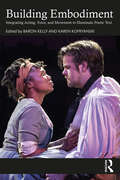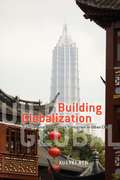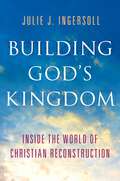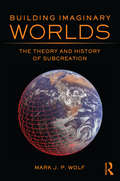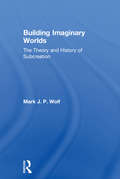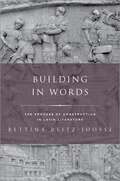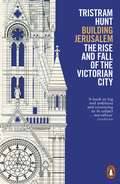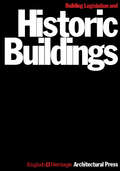- Table View
- List View
Building Embodiment: Integrating Acting, Voice, and Movement to Illuminate Poetic Text
Building Embodiment: Integrating Acting, Voice, and Movement to Illuminate Poetic Text offers a collection of strategic and practical approaches to understanding, analyzing, and embodying a range of heightened text styles, including Greek tragedy, Shakespeare, and Restoration/comedy of manners. These essays offer insights from celebrated teachers across the disciplines of acting, voice, and movement and are designed to help actors and instructors find deeper vocal and physical connections to poetic text. Although each dramatic genre offers a unique set of challenges, Building Embodiment highlights instances where techniques can be integrated, revealing how the synthesis of body, brain, and word results in a fuller sense of character experiencing for both the actor and the audience. This book bridges the gap between academic and professional application and invites the student and professional actor into a richer experience of character and story.
Building Europe Through Education, Building Education Through Europe: Actors, Spaces and Pedagogies in a Historical Perspective (Routledge Studies in Modern European History)
by Simone Paoli Raphaëlle Ruppen CoutazThis edited volume explores the role of education in the process of European cooperation and integration as it has been conceived and realized in the late 20th century and the early 21st century, as well as the mirror of this narrative: the effects of the European integration process on education.Through this dual analysis, the contributors reflect on the concept of Europeanization by showing the complex interplay between Europeanization through education and Europeanization of education. Part I offers a critical overview of the actors, spaces, actions, and pedagogies designed to promote the European project and build Europeans. Part II examines how work done on the European continental level has impacted the educational sphere and national education systems. The case studies cover a wide range of international institutions (College of Europe, European Schools, European Centre for Culture, European University Institute), international organizations (EC/ EU, OEEC/ OECD, Council of Europe, UNESCO), and transnational actors (European Trade Union Committee for Education, European Federation of Education Employers), providing interdisciplinary insight into how this dialectic contributed to shape Europe as a whole.This book will be of interest to graduate and postgraduate students, teachers, and researchers of international cultural relations, Europeanization, and education from a transnational perspective.
Building Europe Through Education, Building Education Through Europe: Actors, Spaces and Pedagogies in a Historical Perspective (Routledge Studies in Modern European History)
This edited volume explores the role of education in the process of European cooperation and integration as it has been conceived and realized in the late 20th century and the early 21st century, as well as the mirror of this narrative: the effects of the European integration process on education.Through this dual analysis, the contributors reflect on the concept of Europeanization by showing the complex interplay between Europeanization through education and Europeanization of education. Part I offers a critical overview of the actors, spaces, actions, and pedagogies designed to promote the European project and build Europeans. Part II examines how work done on the European continental level has impacted the educational sphere and national education systems. The case studies cover a wide range of international institutions (College of Europe, European Schools, European Centre for Culture, European University Institute), international organizations (EC/ EU, OEEC/ OECD, Council of Europe, UNESCO), and transnational actors (European Trade Union Committee for Education, European Federation of Education Employers), providing interdisciplinary insight into how this dialectic contributed to shape Europe as a whole.This book will be of interest to graduate and postgraduate students, teachers, and researchers of international cultural relations, Europeanization, and education from a transnational perspective.
Building Globalization: Transnational Architecture Production in Urban China
by Xuefei RenFrom the years 2004 to 2008, Beijing and Shanghai witnessed the construction of an extraordinary number of new buildings, many of which were designed by architectural firms overseas. Combining ethnographic fieldwork, historical research, and network analysis, Building Globalization closely scrutinizes the growing phenomenon of transnational architecture and its profound effect on the development of urban space. Roaming from construction sites in Shanghai to architects’ offices in Paris, Xuefei Ren interviews hundreds of architects, developers, politicians, residents, and activists to explore this issue. She finds that in the rapidly transforming cities of modern China, iconic designs from prestigious international architects help private developers to distinguish their projects, government officials to advance their careers, and the Chinese state to announce the arrival of modern China on the world stage. China leads the way in the globalization of architecture, a process whose ramifications can be felt from Beijing to Dubai to Basel. Connecting the dots between real estate speculation, megaproject construction, residential displacement, historical preservation, housing rights, and urban activism, Building Globalization reveals the contradictions and consequences of this new, global urban frontier.
Building Globalization: Transnational Architecture Production in Urban China
by Xuefei RenFrom the years 2004 to 2008, Beijing and Shanghai witnessed the construction of an extraordinary number of new buildings, many of which were designed by architectural firms overseas. Combining ethnographic fieldwork, historical research, and network analysis, Building Globalization closely scrutinizes the growing phenomenon of transnational architecture and its profound effect on the development of urban space. Roaming from construction sites in Shanghai to architects’ offices in Paris, Xuefei Ren interviews hundreds of architects, developers, politicians, residents, and activists to explore this issue. She finds that in the rapidly transforming cities of modern China, iconic designs from prestigious international architects help private developers to distinguish their projects, government officials to advance their careers, and the Chinese state to announce the arrival of modern China on the world stage. China leads the way in the globalization of architecture, a process whose ramifications can be felt from Beijing to Dubai to Basel. Connecting the dots between real estate speculation, megaproject construction, residential displacement, historical preservation, housing rights, and urban activism, Building Globalization reveals the contradictions and consequences of this new, global urban frontier.
Building Globalization: Transnational Architecture Production in Urban China
by Xuefei RenFrom the years 2004 to 2008, Beijing and Shanghai witnessed the construction of an extraordinary number of new buildings, many of which were designed by architectural firms overseas. Combining ethnographic fieldwork, historical research, and network analysis, Building Globalization closely scrutinizes the growing phenomenon of transnational architecture and its profound effect on the development of urban space. Roaming from construction sites in Shanghai to architects’ offices in Paris, Xuefei Ren interviews hundreds of architects, developers, politicians, residents, and activists to explore this issue. She finds that in the rapidly transforming cities of modern China, iconic designs from prestigious international architects help private developers to distinguish their projects, government officials to advance their careers, and the Chinese state to announce the arrival of modern China on the world stage. China leads the way in the globalization of architecture, a process whose ramifications can be felt from Beijing to Dubai to Basel. Connecting the dots between real estate speculation, megaproject construction, residential displacement, historical preservation, housing rights, and urban activism, Building Globalization reveals the contradictions and consequences of this new, global urban frontier.
Building Globalization: Transnational Architecture Production in Urban China
by Xuefei RenFrom the years 2004 to 2008, Beijing and Shanghai witnessed the construction of an extraordinary number of new buildings, many of which were designed by architectural firms overseas. Combining ethnographic fieldwork, historical research, and network analysis, Building Globalization closely scrutinizes the growing phenomenon of transnational architecture and its profound effect on the development of urban space. Roaming from construction sites in Shanghai to architects’ offices in Paris, Xuefei Ren interviews hundreds of architects, developers, politicians, residents, and activists to explore this issue. She finds that in the rapidly transforming cities of modern China, iconic designs from prestigious international architects help private developers to distinguish their projects, government officials to advance their careers, and the Chinese state to announce the arrival of modern China on the world stage. China leads the way in the globalization of architecture, a process whose ramifications can be felt from Beijing to Dubai to Basel. Connecting the dots between real estate speculation, megaproject construction, residential displacement, historical preservation, housing rights, and urban activism, Building Globalization reveals the contradictions and consequences of this new, global urban frontier.
Building Globalization: Transnational Architecture Production in Urban China
by Xuefei RenFrom the years 2004 to 2008, Beijing and Shanghai witnessed the construction of an extraordinary number of new buildings, many of which were designed by architectural firms overseas. Combining ethnographic fieldwork, historical research, and network analysis, Building Globalization closely scrutinizes the growing phenomenon of transnational architecture and its profound effect on the development of urban space. Roaming from construction sites in Shanghai to architects’ offices in Paris, Xuefei Ren interviews hundreds of architects, developers, politicians, residents, and activists to explore this issue. She finds that in the rapidly transforming cities of modern China, iconic designs from prestigious international architects help private developers to distinguish their projects, government officials to advance their careers, and the Chinese state to announce the arrival of modern China on the world stage. China leads the way in the globalization of architecture, a process whose ramifications can be felt from Beijing to Dubai to Basel. Connecting the dots between real estate speculation, megaproject construction, residential displacement, historical preservation, housing rights, and urban activism, Building Globalization reveals the contradictions and consequences of this new, global urban frontier.
Building Globalization: Transnational Architecture Production in Urban China
by Xuefei RenFrom the years 2004 to 2008, Beijing and Shanghai witnessed the construction of an extraordinary number of new buildings, many of which were designed by architectural firms overseas. Combining ethnographic fieldwork, historical research, and network analysis, Building Globalization closely scrutinizes the growing phenomenon of transnational architecture and its profound effect on the development of urban space. Roaming from construction sites in Shanghai to architects’ offices in Paris, Xuefei Ren interviews hundreds of architects, developers, politicians, residents, and activists to explore this issue. She finds that in the rapidly transforming cities of modern China, iconic designs from prestigious international architects help private developers to distinguish their projects, government officials to advance their careers, and the Chinese state to announce the arrival of modern China on the world stage. China leads the way in the globalization of architecture, a process whose ramifications can be felt from Beijing to Dubai to Basel. Connecting the dots between real estate speculation, megaproject construction, residential displacement, historical preservation, housing rights, and urban activism, Building Globalization reveals the contradictions and consequences of this new, global urban frontier.
Building God's Kingdom: Inside the World of Christian Reconstruction
by Julie J. IngersollFor the last several decades, at the far fringes of American evangelical Christianity has stood an intellectual movement known as Christian Reconstruction. The proponents of this movement embrace a radical position: that all of life should be brought under the authority of biblical law as it is contained in both the Old and New Testaments. They challenge the legitimacy of democracy, argue that slavery is biblically justifiable, and support the death penalty for all manner of "crimes" described in the Bible including homosexuality, adultery, and Sabbath-breaking. But, as Julie Ingersoll shows in this fascinating new book, this "Biblical Worldview" shapes their views not only on political issues, but on everything from private property and economic policy to history and literature. Holding that the Bible provides a coherent, internally consistent, and all-encompassing worldview, they seek to remake the entirety of society--church, state, family, economy--along biblical lines. Tracing the movement from its mid-twentieth-century origins in the writings of theologian and philosopher R.J. Rushdoony to its present-day sites of influence, including the Christian Home School movement, advocacy for the teaching of creationism, and the development and rise of the Tea Party, Ingersoll illustrates how Reconstructionists have broadly and subtly shaped conservative American Protestantism over the course of the late-twentieth and early-twenty-first centuries. Drawing on interviews with Reconstructionists themselves as well as extensive research in Reconstructionist publications, Building God's Kingdom offers the most complete and balanced portrait to date of this enigmatic segment of the Christian Right.
Building God's Kingdom: Inside the World of Christian Reconstruction
by Julie J. IngersollFor the last several decades, at the far fringes of American evangelical Christianity has stood an intellectual movement known as Christian Reconstruction. The proponents of this movement embrace a radical position: that all of life should be brought under the authority of biblical law as it is contained in both the Old and New Testaments. They challenge the legitimacy of democracy, argue that slavery is biblically justifiable, and support the death penalty for all manner of "crimes" described in the Bible including homosexuality, adultery, and Sabbath-breaking. But, as Julie Ingersoll shows in this fascinating new book, this "Biblical Worldview" shapes their views not only on political issues, but on everything from private property and economic policy to history and literature. Holding that the Bible provides a coherent, internally consistent, and all-encompassing worldview, they seek to remake the entirety of society--church, state, family, economy--along biblical lines. Tracing the movement from its mid-twentieth-century origins in the writings of theologian and philosopher R.J. Rushdoony to its present-day sites of influence, including the Christian Home School movement, advocacy for the teaching of creationism, and the development and rise of the Tea Party, Ingersoll illustrates how Reconstructionists have broadly and subtly shaped conservative American Protestantism over the course of the late-twentieth and early-twenty-first centuries. Drawing on interviews with Reconstructionists themselves as well as extensive research in Reconstructionist publications, Building God's Kingdom offers the most complete and balanced portrait to date of this enigmatic segment of the Christian Right.
Building The Goodly Fellowship Of Faith: A History of the Episcopal Church in Utah, 1867-1996
by Frederick QuinnAs this critical, independent history, which ends with the ordination of one of the first women bishops in the nation, shows, Utah Episcopalians have had, despite small numbers, a remarkably eventful and significant history, which included complex relations with Mormons and Native Americans, early experience of women and homosexuals in the ministry, and a fascinating set of bishops. Among the latter were Daniel Tuttle, a leading figure in Episcopal history; Christian socialist and Social Gospel proponent Frank Spencer Spalding; and Paul Jones, forced to resign because of his pacifism during WWI. Frederick Quinn, an Episcopal priest and historian, is adjunct professor of history at Utah State University and adjunct professor of political science at the University of Utah. His previous books include Democracy at Dawn, Notes From Poland and Points East, a TLS International Book of the Year, and African Saints, Martyrs, and Holy People, a Black Catholic Congress Book of the Month. A former chaplain at Washington National Cathedral, he holds a doctorate in history from the University of California at Los Angeles.
Building Histories: The Archival and Affective Lives of Five Monuments in Modern Delhi (South Asia Across the Disciplines)
by Mrinalini RajagopalanBuilding Histories offers innovative accounts of five medieval monuments in Delhi—the Red Fort, Rasul Numa Dargah, Jama Masjid, Purana Qila, and the Qutb complex—tracing their modern lives from the nineteenth century into the twentieth. Mrinalini Rajagopalan argues that the modern construction of the history of these monuments entailed the careful selection, manipulation, and regulation of the past by both the colonial and later postcolonial states. Although framed as objective “archival” truths, these histories were meant to erase or marginalize the powerful and persistent affective appropriations of the monuments by groups who often existed outside the center of power. By analyzing these archival and affective histories together, Rajagopalan works to redefine the historic monument—far from a symbol of a specific past, the monument is shown in Building Histories to be a culturally mutable object with multiple stories to tell.
Building Histories: The Archival and Affective Lives of Five Monuments in Modern Delhi (South Asia Across the Disciplines)
by Mrinalini RajagopalanBuilding Histories offers innovative accounts of five medieval monuments in Delhi—the Red Fort, Rasul Numa Dargah, Jama Masjid, Purana Qila, and the Qutb complex—tracing their modern lives from the nineteenth century into the twentieth. Mrinalini Rajagopalan argues that the modern construction of the history of these monuments entailed the careful selection, manipulation, and regulation of the past by both the colonial and later postcolonial states. Although framed as objective “archival” truths, these histories were meant to erase or marginalize the powerful and persistent affective appropriations of the monuments by groups who often existed outside the center of power. By analyzing these archival and affective histories together, Rajagopalan works to redefine the historic monument—far from a symbol of a specific past, the monument is shown in Building Histories to be a culturally mutable object with multiple stories to tell.
Building Histories: The Archival and Affective Lives of Five Monuments in Modern Delhi (South Asia Across the Disciplines)
by Mrinalini RajagopalanBuilding Histories offers innovative accounts of five medieval monuments in Delhi—the Red Fort, Rasul Numa Dargah, Jama Masjid, Purana Qila, and the Qutb complex—tracing their modern lives from the nineteenth century into the twentieth. Mrinalini Rajagopalan argues that the modern construction of the history of these monuments entailed the careful selection, manipulation, and regulation of the past by both the colonial and later postcolonial states. Although framed as objective “archival” truths, these histories were meant to erase or marginalize the powerful and persistent affective appropriations of the monuments by groups who often existed outside the center of power. By analyzing these archival and affective histories together, Rajagopalan works to redefine the historic monument—far from a symbol of a specific past, the monument is shown in Building Histories to be a culturally mutable object with multiple stories to tell.
Building Histories: The Archival and Affective Lives of Five Monuments in Modern Delhi (South Asia Across the Disciplines)
by Mrinalini RajagopalanBuilding Histories offers innovative accounts of five medieval monuments in Delhi—the Red Fort, Rasul Numa Dargah, Jama Masjid, Purana Qila, and the Qutb complex—tracing their modern lives from the nineteenth century into the twentieth. Mrinalini Rajagopalan argues that the modern construction of the history of these monuments entailed the careful selection, manipulation, and regulation of the past by both the colonial and later postcolonial states. Although framed as objective “archival” truths, these histories were meant to erase or marginalize the powerful and persistent affective appropriations of the monuments by groups who often existed outside the center of power. By analyzing these archival and affective histories together, Rajagopalan works to redefine the historic monument—far from a symbol of a specific past, the monument is shown in Building Histories to be a culturally mutable object with multiple stories to tell.
Building Imaginary Worlds: The Theory and History of Subcreation
by Mark J.P. WolfMark J.P. Wolf’s study of imaginary worlds theorizes world-building within and across media, including literature, comics, film, radio, television, board games, video games, the Internet, and more. Building Imaginary Worlds departs from prior approaches to imaginary worlds that focused mainly on narrative, medium, or genre, and instead considers imaginary worlds as dynamic entities in and of themselves. Wolf argues that imaginary worlds—which are often transnarrative, transmedial, and transauthorial in nature—are compelling objects of inquiry for Media Studies. Chapters touch on: a theoretical analysis of how world-building extends beyond storytelling, the engagement of the audience, and the way worlds are conceptualized and experienced a history of imaginary worlds that follows their development over three millennia from the fictional islands of Homer’s Odyssey to the present internarrative theory examining how narratives set in the same world can interact and relate to one another an examination of transmedial growth and adaptation, and what happens when worlds make the jump between media an analysis of the transauthorial nature of imaginary worlds, the resulting concentric circles of authorship, and related topics of canonicity, participatory worlds, and subcreation’s relationship with divine Creation Building Imaginary Worlds also provides the scholar of imaginary worlds with a glossary of terms and a detailed timeline that spans three millennia and more than 1,400 imaginary worlds, listing their names, creators, and the works in which they first appeared.
Building Imaginary Worlds: The Theory and History of Subcreation
by Mark J.P. WolfMark J.P. Wolf’s study of imaginary worlds theorizes world-building within and across media, including literature, comics, film, radio, television, board games, video games, the Internet, and more. Building Imaginary Worlds departs from prior approaches to imaginary worlds that focused mainly on narrative, medium, or genre, and instead considers imaginary worlds as dynamic entities in and of themselves. Wolf argues that imaginary worlds—which are often transnarrative, transmedial, and transauthorial in nature—are compelling objects of inquiry for Media Studies. Chapters touch on: a theoretical analysis of how world-building extends beyond storytelling, the engagement of the audience, and the way worlds are conceptualized and experienced a history of imaginary worlds that follows their development over three millennia from the fictional islands of Homer’s Odyssey to the present internarrative theory examining how narratives set in the same world can interact and relate to one another an examination of transmedial growth and adaptation, and what happens when worlds make the jump between media an analysis of the transauthorial nature of imaginary worlds, the resulting concentric circles of authorship, and related topics of canonicity, participatory worlds, and subcreation’s relationship with divine Creation Building Imaginary Worlds also provides the scholar of imaginary worlds with a glossary of terms and a detailed timeline that spans three millennia and more than 1,400 imaginary worlds, listing their names, creators, and the works in which they first appeared.
Building in Words: Representations of the Process of Construction in Latin Literature (Classical Culture and Society)
by Bettina Reitz-JoosseBuilding in Words explores the relationship between text and architecture in the Roman world from the perspective of architectural process. Ancient Romans frequently encountered buildings under construction - they experienced noisy building work, disruptive transportation of materials, and sometimes spectacular engineering feats. Bettina Reitz-Joosse analyzes how Roman authors responded to the process of building and construction in their literary works. Roman authors tell stories of architectural creation to give meaning to finished monuments. Their narratives can stress technological or logistic mastery or highlight morally problematic aspects of construction, particularly in large-scale engineering projects. While offering descriptions of the process of creating architecture, Roman writers also reflect on the creation of their own works. Building in Words demonstrates the richness of the image of construction for literary composition: writers use it to comment on the aesthetics or ambition of their literary work, to articulate the power and durability, but also the fragility of literature. Reitz-Joosse here offers original readings of a range of literary authors of the early Roman empire, including Vergil, Pliny the Elder, Tacitus, and Statius, and places literary texts in dialogue with contemporary epigraphic and archaeological material. Through its focus on building as a process, Building in Words furthers our understanding of the aesthetics of both architecture and literature in ancient Rome.
Building in Words: Representations of the Process of Construction in Latin Literature (Classical Culture and Society)
by Bettina Reitz-JoosseBuilding in Words explores the relationship between text and architecture in the Roman world from the perspective of architectural process. Ancient Romans frequently encountered buildings under construction - they experienced noisy building work, disruptive transportation of materials, and sometimes spectacular engineering feats. Bettina Reitz-Joosse analyzes how Roman authors responded to the process of building and construction in their literary works. Roman authors tell stories of architectural creation to give meaning to finished monuments. Their narratives can stress technological or logistic mastery or highlight morally problematic aspects of construction, particularly in large-scale engineering projects. While offering descriptions of the process of creating architecture, Roman writers also reflect on the creation of their own works. Building in Words demonstrates the richness of the image of construction for literary composition: writers use it to comment on the aesthetics or ambition of their literary work, to articulate the power and durability, but also the fragility of literature. Reitz-Joosse here offers original readings of a range of literary authors of the early Roman empire, including Vergil, Pliny the Elder, Tacitus, and Statius, and places literary texts in dialogue with contemporary epigraphic and archaeological material. Through its focus on building as a process, Building in Words furthers our understanding of the aesthetics of both architecture and literature in ancient Rome.
Building Information Modelling im Planungs- und Bauprozess: Eine quantitative Analyse aus planungsökonomischer Perspektive
by Matthias StangeMatthias Stange untersucht die Auswirkungen der Anwendung von Building Information Modelling (BIM) im Planungs- und Bauprozess aus planungsökonomischer Perspektive. Ziel der Untersuchung ist es, die aus zahlreichen qualitativen Studien abgeleiteten Verbesserungspotentiale durch die Anwendung der BIM-Methode anhand realer Projektdaten im globalen Kontext zu überprüfen. Mit quantitativen Methoden analysiert der Autor Primärdaten aus weltweit 105 Bauprojekten der Bereiche Wohnbau, Gewerbebau, Industriebau, Infrastruktur- und Wasserbau. Dabei wird dem Einfluss des projektbezogenen BIM-Reifegrades besondere Beachtung eingeräumt.
Building Jerusalem: The Rise and Fall of the Victorian City
by Tristram Hunt'History writing at its compulsive best' A. N. WilsonThis is a history of the ideas that shaped not only London, but Manchester, Glasgow, Liverpool, Leeds, Birmingham, Sheffield and other power-houses of 19th-century Britain. It charts the controversies and visions that fostered Britain's greatest civic renaissance.Tristram Hunt explores the horrors of the Victorian city, as seen by Dickens, Engels and Carlyle; the influence of the medieval Gothic ideal of faith, community and order espoused by Pugin and Ruskin; the pride in self-government, identified with the Saxons as opposed to the Normans; the identification with the city republics of the Italian renaissance - commerce, trade and patronage; the change from the civic to the municipal, and greater powers over health, education and housing; and finally at the end of the century, the retreat from the urban to the rural ideal, led by William Morris and the garden-city movement of Ebenezer Howard.
Building Jerusalem: Art, Industry and the British Millennium
by John PickA lively and provocative account of the arts in Britain, Building Jerusalem suggests that even after fifty years of state planning of Britain's "leisure industries" the country is nevertheless approaching the millennium in a state of cultural confusion. Drawing on a wealth of historical material from Scotland, Wales, and English provincial towns, as well as the more familiar London story, Pick and Anderton contend that the original meaning of cultural language has been distorted by the fashionable phrase-making of modern government agencies, and by the inaccurate and misleading view of cultural history that is constantly presented to the public. The authors unfold fascinating stories of Britain's cultural past, before state support of the arts. They vividly relate the great changes wrought by the industrial revolution and by the development of the twentieth century media and describe the long history of Church and Royal support for the arts, as well as the long periods when all of the arts
Building Jerusalem: Art, Industry and the British Millennium
by John PickA lively and provocative account of the arts in Britain, Building Jerusalem suggests that even after fifty years of state planning of Britain's "leisure industries" the country is nevertheless approaching the millennium in a state of cultural confusion. Drawing on a wealth of historical material from Scotland, Wales, and English provincial towns, as well as the more familiar London story, Pick and Anderton contend that the original meaning of cultural language has been distorted by the fashionable phrase-making of modern government agencies, and by the inaccurate and misleading view of cultural history that is constantly presented to the public. The authors unfold fascinating stories of Britain's cultural past, before state support of the arts. They vividly relate the great changes wrought by the industrial revolution and by the development of the twentieth century media and describe the long history of Church and Royal support for the arts, as well as the long periods when all of the arts
Building Legislation and Historic Buildings: A Guide to the Application of the Building Regulations, the Public Health Acts, the Fire Precautions Act, the Housing Act and Other Legislation Relevant to Historic Buildings
by Alan C. ParnellBuilding Legislation and Historic Buildings offers a guide to the application of the Building Regulations, the Public Health Acts, the Fire Precautions Act, the Housing Act and other legislation relevant to historic buildings. The purpose is to aid the architect in tackling his own design problems and support him in his negotiations with the various controlling authorities. This book reviews the statutory controls exercised in England and Wales, including London, by local authorities over historic buildings in use, and when alterations or a change of use are proposed. It indicates the impact of such controls on the character and environment of historic buildings, outlining the main problems that result, and showing how far and in what ways they can be resolved. It considers the case for relaxing some buildings from control in the interests of conservation of historic character. It examines the possibility of improving the application of the various administrative procedures to historic buildings. It also attempts to increase understanding of the problems of the continuing use of historic buildings and the current standards for safety and amenity and recommending ways in which this understanding can best be promoted.
